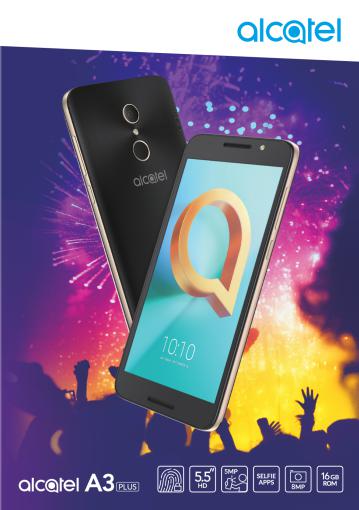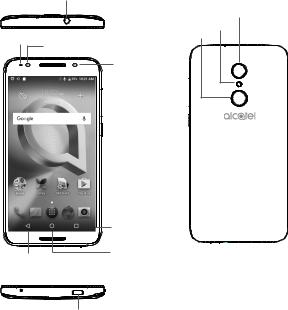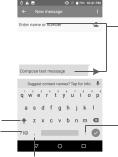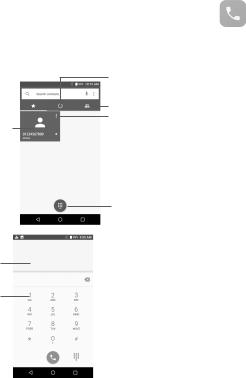Alcatel 5011A Operating Guide


Table of Contents
Safety and use................................................................................ |
4 |
||
General information..................................................................... |
14 |
||
1 |
Your mobile............................................................................ |
16 |
|
|
1.1 |
Keys and connectors................................................................... |
16 |
|
1.2 |
Getting started............................................................................. |
18 |
|
1.3 |
Home screen............................................................................... |
19 |
2 |
Text input................................................................................ |
26 |
|
|
2.1 |
Using the Onscreen Keyboard.................................................... |
26 |
|
2.2 |
Text editing.................................................................................. |
27 |
3 |
Call, Call log and Contacts................................................... |
28 |
|
|
3.1 |
Phone call.................................................................................... |
28 |
|
3.2 |
Call log......................................................................................... |
34 |
|
3.3 |
Contacts...................................................................................... |
34 |
4 |
Messaging.............................................................................. |
40 |
|
|
4.1 |
Write a new message.................................................................. |
40 |
|
4.2 |
Manage messages...................................................................... |
42 |
|
4.3 |
Adjust message settings............................................................. |
43 |
5 |
Calendar & Alarm clock & Calculator.................................. |
46 |
|
|
5.1 |
Calendar...................................................................................... |
46 |
|
5.2 |
Time ............................................................................................ |
48 |
|
5.3 |
Calculator.................................................................................... |
50 |
6 |
Getting connected................................................................. |
52 |
|
|
6.1 |
Connecting to the Internet........................................................... |
52 |
|
6.2 |
Connecting to Bluetooth devices ................................................ |
54 |
|
6.3 |
Connecting to a computer via USB............................................. |
55 |
|
6.4 |
Sharing your phone's mobile data connection............................ |
56 |
|
6.5 |
Connecting to virtual private networks........................................ |
57 |
1
7 Multimedia applications........................................................ |
59 |
|
7.1 |
Camera........................................................................................ |
59 |
7.2 |
Gallery......................................................................................... |
62 |
7.3 |
Music........................................................................................... |
65 |
8 Others..................................................................................... |
66 |
|
8.1 |
File Manager................................................................................ |
66 |
8.2 |
Sound Recorder.......................................................................... |
66 |
8.3 |
Radio........................................................................................... |
67 |
8.4 |
Alcatel Launcher.......................................................................... |
68 |
9 Google applications ............................................................. |
69 |
|
9.1 |
Play Store.................................................................................... |
69 |
9.2 |
Chrome........................................................................................ |
69 |
9.3 |
Gmail........................................................................................... |
70 |
9.4 |
Maps............................................................................................ |
72 |
9.5 |
YouTube....................................................................................... |
72 |
9.6 |
Drive............................................................................................ |
72 |
9.7 |
Play Music................................................................................... |
72 |
9.8 |
Play Movies & TV........................................................................ |
72 |
9.9 |
Photos......................................................................................... |
73 |
9.10 |
Keep............................................................................................ |
73 |
10 Settings................................................................................... |
74 |
|
10.1 |
Wireless & networks.................................................................... |
74 |
10.2 |
Device.......................................................................................... |
76 |
10.3 |
Personal...................................................................................... |
79 |
10.4 |
System......................................................................................... |
84 |
11 Update your phone’s software............................................. |
88 |
|
11.1 |
Mobile Upgrade........................................................................... |
88 |
11.2 |
FOTA Upgrade............................................................................. |
88 |
2

12 |
Accessories............................................................................ |
89 |
13 |
TCL Communication Ltd. Warranty..................................... |
90 |
14 |
Troubleshooting..................................................................... |
92 |
15 |
Specifications........................................................................ |
98 |
This product meets applicable national SAR limits of 1.6 W/kg. The specific maximum SAR values can be found in the RADIOWAVES section of this user guide.
When carrying the product or using it while worn on your body, either use an approved accessory such as
a holster or otherwise maintain a distance of 10 mm www.sar-tick.com from the body to ensure compliance with RF exposure
requirements. Note that the product may be transmitting even if you are not making a phone call.
PROTECT YOUR HEARING
To prevent possible hearing damage, do not listen at high volume levels for long periods. Exercise caution when holding your device near your ear while the loudspeaker is in use.
3
Safety and use.........................................
We recommend that you read this chapter carefully before using your mobile phone. The manufacturer disclaims any liability for damage, which may result as a consequence of improper use or use contrary to the instructions contained herein.
• TRAFFIC SAFETY:
Given that studies show that using a mobile phone while driving a vehicle constitutes a real risk, even when the hands-free kit is used (car kit, headset...), drivers are requested to refrain from using their mobile phone when the vehicle is not parked. Check the laws and regulations on the use of wireless mobile phones and their accessories in the areas where you drive. Always obey them. The use of these devices may be prohibited or restricted in certain areas.
When driving, do not use your mobile phone and headset to listen to music or to the radio. Using a headset can be dangerous and forbidden in some areas.
When switched on, your mobile phone emits electromagnetic waves that can interfere with the vehicle’s electronic systems such as ABS anti-lock brakes or airbags. To ensure that there is no problem:
-do not place your mobile phone on top of the dashboard or within an airbag deployment area,
-check with your car dealer or the car manufacturer to make sure that the car’s electronic devices are shielded from mobile phone RF energy.
• CONDITIONS OF USE:
You are advised to switch off the mobile phone from time to time to optimize its performance.
Remember to abide by local authority rules of mobile phone use on aircrafts.
Operational Warnings: Obey all posted signs when using mobile devices in public areas.
Follow Instructions to Avoid Interference Problems: Turn off your mobile device in any location where posted notices instruct you to do so. In an aircraft, turn off your mobile device whenever instructed to do so by airline staff. If your mobile device offers an airplane mode or similar feature, consult airline staff about using it in flight.
4
Switch the mobile phone off when you are in health care facilities, except in designated areas. As with many other types of equipment now in regular use, mobile phones can interfere with other electrical or electronic devices, or equipment using radio frequency.
Switch the mobile phone off when you are near gas or flammable liquids. Strictly obey all signs and instructions posted in a fuel depot, gas station, or chemical plant, or in any potentially explosive atmosphere.
When the mobile phone is switched on, it should be kept at least 15 cm from any medical device such as a pacemaker, a hearing aid or insulin pump. In particular when using the mobile phone you should hold it against the ear on the opposite side to the device, if any.
Read and follow the directions from the manufacturer of your implantable medical device. If you have any questions about using your mobile device with your implantable medical device, consult your healthcare provider.
To avoid hearing impairment, answer the call before holding your mobile phone to your ear. Also move the handset away from your ear while using the “hands-free” option because the amplified volume might cause hearing damage.
It is recommended to have proper supervision while small children use your mobile phone.
If your phone has a removable cover, note that your phone may contain substances that could create an allergic reaction.
If your phone is a unibody device, the back cover and battery are not removable. If you disassemble your phone the warranty will not apply. Disassembling the phone may damage the battery, and may cause leakage of substances that could create an allergic reaction.
Always handle your mobile phone with care and keep it in a clean and dustfree place.
Do not allow your mobile phone to be exposed to adverse weather or environmental conditions (moisture, humidity, rain, infiltration of liquids, dust, sea air, etc.). The manufacturer’s recommended operating temperature range is -10°C (14°F) to +55°C (131°F) (the max value depends on device, materials and housing paint/texture).
Over 55°C (131°F) the legibility of the mobile phone’s display may be impaired, though this is temporary and not serious.
Do not open or attempt to repair your mobile phone yourself. Do not drop, throw, or try to bend your mobile phone.
5

Do not use the mobile phone if the glass made screen is damaged, cracked, or broken to avoid any injury.
Do not paint it.
Use only batteries, battery chargers, and accessories which are recommended by TCL Communication Ltd. and its affiliates and are compatible with your mobile phone model. TCL Communication Ltd. and its affiliates disclaim any liability for damage caused by the use of other chargers or batteries.
Your mobile phone should not be disposed of in a municipal waste. Please check local regulations for disposal of electronic products.
Remember to make back-up copies or keep a written record of all important information stored in your mobile phone.
Some people may suffer epileptic seizures or blackouts when exposed to flashing lights, or when playing video games. These seizures or blackouts may occur even if a person never had a previous seizure or blackout. If you have experienced seizures or blackouts, or if you have a family history of such occurrences, please consult your doctor before playing video games on your mobile phone or enabling a flashing-lights feature on your mobile phone. Parents should monitor their children’s use of video games or other features that incorporate flashing lights on the mobile phones. All persons should discontinue use and consult a doctor if any of the following symptoms occur: convulsion, eye or muscle twitching, loss of awareness, involuntary movements, or disorientation. To limit the likelihood of such symptoms, please take the following safety precautions:
-Play at the farthest distance possible from the screen. When you play games on your mobile phone, you may experience occasional discomfort in your hands, arms, shoulders, neck, or other parts of your body. Follow these instructions to avoid problems such as tendinitis, carpal tunnel syndrome, or other musculoskeletal disorders:
-Take a minimum of a 15-minute break every hour of game playing.
-If your hands, wrists, or arms become tired or sore while playing, stop and rest for several hours before playing again.
-If you continue to have sore hands, wrists, or arms during or after playing, stop the game and see a doctor.
PROTECT YOUR HEARING
To prevent possible hearing damage, do not listen at high volume levels for long periods. Exercise caution when holding your device near your ear while the loudspeaker is in use.
6
• PRIVACY:
Please note that you must respect the laws and regulations in force in your jurisdiction or other jurisdiction(s) where you will use your mobile phone regarding taking photographs and recording sounds with your mobile phone. Pursuant to such laws and regulations, it may be strictly forbidden to take photographs and/or to record the voices of other people or any of their personal attributes, and reproduce or distribute them, as this may be considered to be an invasion of privacy.
It is the user’s sole responsibility to ensure that prior authorization be obtained, if necessary, in order to record private or confidential conversations or take a photograph of another person; the manufacturer, the seller or vendor of your mobile phone (including the operator) disclaim any liability which may result from the improper use of the mobile phone.
• BATTERY AND ACCESSORIES:
Following new air regulation, the battery of your product is not charged. Please charge it first.
For non-unibody device:
Before removing the battery from your mobile phone, please make sure that the mobile phone is switched off.
Observe the following precautions for battery use:
-Do not attempt to open the battery (due to the risk of toxic fumes and burns).
-Do not puncture, disassemble, or cause a short-circuit in the battery,
-Do not burn or dispose of a used battery in the garbage or store it at temperatures above 60°C (140°F).
Batteries must be disposed of in accordance with locally applicable environmental regulations. Only use the battery for the purpose for which it was designed. Never use damaged batteries or those not recommended by TCL Communication Ltd. and/or its affiliates.
For unibody device:
Please note your phone is a unibody device, the back cover and battery are not removable. Observe the following precautions:
-Do not attempt to open the back cover,
-Do not attempt to eject, replace, or open battery,
-Do not puncture the back cover of your phone,
-Do not burn or dispose of your phone in household garbage or store it at temperature above 60°C.
7

Phone and battery as a unibody device must be disposed of in accordance with locally applicable environmental regulations.
This symbol on your mobile phone, the battery, and the accessories
means that these products must be taken to collection points at the
end of their life:
- Municipal waste disposal centers with specific bins for these types of equipment
- Collection bins at points of sale.
They will then be recycled, preventing substances being disposed of in the environment, so that their components can be reused.
In European Union countries:
These collection points are accessible free of charge. All products with this sign must be brought to these collection points.
In non European Union jurisdictions:
Items of equipment with this symbol are not be thrown into ordinary bins if your jurisdiction or your region has suitable recycling and collection facilities; instead they are to be taken to collection points for them to be recycled.
In the United States you may learn more about CTIA’s Recycling Program at http://www.gowirelessgogreen.org/
CAUTION: RISK OF EXPLOSION IF BATTERY IS REPLACED BY AN INCORRECT TYPE. DISPOSE OF USED BATTERIES ACCORDING TO THE INSTRUCTIONS
• CHARGERS:
Home A.C./ Travel chargers will operate within the temperature range of: 0°C (32°F) to 50°C (122°F).
The chargers designed for your mobile phone meet with the standard for safety of information technology equipment and office equipment use. Due to different applicable electrical specifications, a charger you purchased in one jurisdiction may not work in another jurisdiction. They should be used for this purpose only.
Characteristics of power supply (depending on the country): Travel charger: Input: 100-240 V, 50/60 Hz, 200 mA
|
Output: 5 V, 1A |
Battery: |
Lithium 2500 mAh |
8
• RADIO WAVES:
THIS MOBILE PHONE MEETS THE GOVERNMENT’S REQUIREMENTS FOR EXPOSURE TO RADIO WAVES.
Your mobile phone is a radio transmitter and receiver. It is designed and manufactured not to exceed the emission limits for exposure to radiofrequency (RF) energy. These limits are part of comprehensive guidelines and establish permitted levels of RF energy for the general population. The guidelines are based on standards that were developed by independent scientific organizations through periodic and thorough evaluation of scientific studies. These guidelines include a substantial safety margin designed to ensure the safety of all persons, regardless of age and health.
The exposure standard for mobile phones employs a unit of measurement known as the Specific Absorption Rate, or SAR. The SAR limit set by public authorities such as the Federal Communications Commission of the US Government (FCC), or by Industry Canada, is 1.6 W/kg averaged over 1 gram of body tissue. Tests for SAR are conducted using standard operating positions with the mobile phone transmitting at its highest certified power level in all tested frequency bands.
Although the SAR is determined at the highest certified power level, the actual SAR level of the mobile phone while operating can be well below the maximum value. This is because the mobile phone is designed to operate at multiple power levels so as to use only the power required to reach the network. In general, the closer you are to a wireless base station antenna, the lower the power output of the mobile phone. Before a mobile phone model is available for sale to the public, compliance with national regulations and standards must be shown.
The highest SAR value for this model mobile phone when tested is 0.64 W/Kg for use at the ear and 1.37 W/Kg for use close to the body.
While there may be differences between the SAR levels of various mobile phones and at various positions, they all meet the government requirement for RF exposure. For body-worn operation, the mobile phone meets FCC RF exposure guidelines provided that it is used with a non-metallic accessory with the handset at least 10 mm from the body. Use of other accessories may not ensure compliance with FCC RF exposure guidelines.
Additional information on SAR can be found on the Cellular Telecommunications & Internet Association (CTIA) Web site: http://www.ctia.org/
9
The World Health Organization (WHO) considers that present scientific information does not indicate the need for any special precautions for use of mobile phones. If individuals are concerned, they might choose to limit their own or their children’s RF exposure by limiting the length of calls, or using “hands-free” devices to keep mobile phones away from the head and body. (fact sheet n°193). Additional WHO information about electromagnetic fields and public health are available on the following website: http://www.who.int/ peh-emf.
Note: This equipment has been tested and found to comply with the limits for a Class B digital device pursuant to part 15 of the FCC Rules. These limits are designed to provide reasonable protection against harmful interference in a residential installation. This equipment generates, uses and can radiate radio frequency energy and, if not installed and used in accordance with the instructions, may cause harmful interference to radio communications. However, there is no guarantee that interference to radio or television reception, which can be determined by turning the equipment off and on, the user is encouraged to try to correct the interference by one or more of the following measures:
-Reorient or relocate the receiving antenna.
-Increase the separation between the equipment and receiver.
-Connect the equipment into an outlet on a circuit different from that to which the receiver is connected.
-Consult the dealer or an experienced radio/ TV technician for help.
Changes or modifications not expressly approved by the party responsible for compliance could void the user’s authority to operate the equipment.
For the receiver devices associated with the operation of a licensed radio service (e.g. FM broadcast), they bear the following statement:
This device complies with Part 15 of the FCC Rules. Operation is subject to the condition that this device does not cause harmful interference.
For other devices, they bear the following statement:
10
This device complies with Part 15 of the FCC Rules. Operation is subject to the following two conditions:
(1)this device may not cause harmful interference
(2)this device must accept any interference received, including interference that may cause undesired operation.
Your mobile phone is equipped with a built-in antenna. For optimal operation, you should avoid touching it or degrading it.
As mobile devices offer a range of functions, they can be used in positions other than against your ear. In such circumstances the device will be compliant with the guidelines when used with headset or usb data cable. If you are using another accessory ensure that whatever product is used is free of any metal and that it positions the mobile phone at least 10 mm away from the body.
Please note by using the device some of your personal data may be shared with the main device. It is under your own responsibility to protect your own personal data, not to share with it with any unauthorized devices or third party devices connected to yours. For products with Wi-Fi features, only connect to trusted Wi-Fi networks. Also when using your product as a hotspot (where available), use network security. These precautions will help prevent unauthorized access to your device. Your product can store personal information in various locations including a SIM card, memory card, and builtin memory. Be sure to remove or clear all personal information before you recycle, return, or give away your product. Choose your apps and updates carefully, and install from trusted sources only. Some apps can impact your product’s performance and/or have access to private information including account details, call data, location details and network resources.
Note that any data shared with TCL Communication Ltd. is stored in accordance with applicable data protection legislation. For these purposes TCL Communication Ltd. implements and maintains appropriate technical and organizational measures to protect all personal data, for example against unauthorized or unlawful processing and accidental loss or destruction of or damage to such personal data whereby the measures shall provide a level of security that is appropriate having regard to
11
(i)the technical possibilities available,
(ii)the costs for implementing the measures,
(iii)the risks involved with the processing of the personal data, and
(iv)the sensitivity of the personal data processed.
You can access, review and edit your personal information at any time by logging into your user account, visiting your user profile or by contacting us directly. Should you require us to edit or delete your personal data, we may ask you to provide us with evidence of your identity before we can act on your request.
12

• LICENCES:
microSD Logo is a trademark.
The Bluetooth word mark and logos are owned by the Bluetooth SIG, Inc. and any use of such marks by TCL Communication Ltd. and its affiliates is under license. Other trademarks and trade names are those of their respective owners.
ALCATEL 5011A Bluetooth Declaration ID D026888
The Wi-Fi Logo is a certification mark of the Wi-Fi Alliance.
Google, the Google logo, Android, the Android logo, Google SearchTM, Google MapsTM, GmailTM, YouTube, Google Play Store, Google LatitudeTM and HangoutsTM are trademarks of Google Inc.
The Android robot is reproduced or modified from work created and shared by Google and used according to terms described in the Creative Commons 3.0 Attribution License (the text will show when you touch and hold Google legal in Settings\About phone\Legal information). (1)
You have purchased a product which uses the open source (http://opensource. org/) programs mtd, msdosfs, netfilter/iptables and initrd in object code and other open source programs licensed under the GNU General Public License and Apache License.
We will provide you with a complete copy of the corresponding source codes upon request within a period of three years from the distribution of the product by TCL Communication.
You may download the source codes from http://sourceforge.net/projects/ alcatel/files/. The provision of the source code is free of charge from the internet.
Hearing Aid Compatibility
Your mobile phone is rated: «For Hearing Aid», to assist hearing device users in finding mobile phones that may be compatible with their hearing devices.
This device is HAC M4 compatible. Reference ANSI C63.19-2011 For more information please visit our website http://www.alcatel-mobile.com.us
FCC ID: 2ACCJB091
(1)May not be available in all countries.
13
General information................................
•Website: www.alcatel-mobile.com
•Facebook: http://www.facebook.com/alcatelonetouch
•Twitter: http://www.twitter.com/alcatelonetouch
•Hot Line Number: In the United States, call 855-368-0829 for technical support. In Canada, call 855-844-6058 for technical support.
•Electronic labeling path: Touch Settings\Regulatory & Safety or press *#07#, you can find more information about labeling (1).
On our Website you will find our FAQ (Frequently Asked Questions) section. You can also contact us by e-mail to ask any questions you may have.
An electronic version of this user guide is available in English and other languages according to availability on our server: www.alcatel-mobile.com
Your phone is a transceiver that operates on GSM in quad-band (850/900/1800/1900 MHz), UMTS in penta-band (850/900/1700/1900/2100 MHz).
(1)May not be available in all countries.
14
Protection against theft (1)
Your mobile phone is identified by an IMEI (mobile phone serial number) shown on the packaging label and in the product’s memory. We recommend that you note the number the first time you use your mobile phone by entering *#06# and keep it in a safe place. It may be requested by the police or your operator if your mobile phone is stolen.
Disclaimer
There may be certain differences between the user manual description and the mobile phone’s operation, depending on the software release of your mobile phone or specific operator services.
TCL Communication Ltd. shall not be held legally responsible for such differences, if any, nor for their potential consequences, which responsibility shall be borne by the operator exclusively.
(1)Contact your network operator to check service availability.
15

1 Your mobile......................................
1.1Keys and connectors
Headset connector
Camera
Camera Flash
LED indicatort Front Camera Fingerprint
Front camera flash

 Volume key
Volume key


 Power key
Power key
Back key |
Back key
Recent apps button
Micro-USB Connector
16

Overview key
• Touch to switch between individual app activities and documents.
Home key
•From any application or screen, touch to return to the Home screen.
•Long press to turn on Google Now.
Back key
•Touch to go back to the previous screen, or close a dialog box, options menu, the notification panel, etc.
Power key
•Press: Lock the screen/Light up the screen.
•Press and hold: Show the popup menu to select from Restart, Power off, and Aeroplane mode.
•Press and hold the Power key for at least 10 seconds to force reboot.
•Press and hold the Power key and Volume up key under power off mode to enter recovery mode.
•Press and hold the Power key and Volume down key to make a screenshot.
Volume Keys
•During a call, adjusts the earpiece or headset volume.
•In Music/Video/Streaming mode, adjusts the media volume.
•In general mode, adjusts the ringtone volume.
•Mutes the ringtone of an incoming call.
17

1.2Getting started
1.2.1Set up
Inserting or removing the SIM/microSD card
A micro-SIM card is required to make phone calls and use mobile networks. If you have a SIM card, insert it before setting up the phone. Do not attempt to insert other SIM types like mini or nano cards, as you may damage your phone.
Power off your phone before inserting or removing the SIM/microSD card.
Charging the battery
You are advised to fully charge the battery. Charging status is indicated by a percentage displayed on screen while the phone is powered off. The percentage increases as the phone is charged.
To reduce power consumption and energy waste, disconnect your charger when the battery is fully charged; switch off Wi-Fi, GPS, Bluetooth or apps running in the background when not needed. In Settings you can also lower the brightness of the screen, and shorten the length of time before the screen goes to sleep.
1.2.2Power on your phone
To turn your phone on, hold down the Power key until the phone powers on. It will take a few seconds before the screen lights up. Unlock your phone with a swipe, PIN, password or pattern before the Home screen can display if you've set a screen lock in Settings.
If you do not know your PIN code or if you have forgotten it, contact your network operator. Do not leave your PIN code with your phone. Store this information in a safe place when not in use.
1.2.3Power off your phone
To turn your phone off, hold down the Power key until the Phone options appear, then select Power off.
18

1.3Home screen
Touching the Home key always takes you to your main Home screen, and you can personalise all your Home screens by adding your favourite apps, shortcuts and widgets to them. On the Home screen the bottom set of icons is always visible, whichever of your Home pages you are on. This also includes the Application tab, which will show all your available apps.
Status bar
•Status/Notification indicators
•Touch and drag down to open the
notification panel
Google Search bar
•Touch to enter text search screen
•Touch to enter voice search screen
Slide left or right to see other panels on the
Home screen
Favourite tray applications
•Touch to enter the application
•Long press to move or remove applications
 Application tab
Application tab
• Touch to open all apps
The Home screen extends to allow more space for adding applications, shortcuts, etc. Slide the Home screen horizontally left and right to get a complete view of the Home screen. The white spot in the lower part of the screen indicates which screen you are viewing.
1.3.1Using the touchscreen
Touch
To open an application, touch it with your finger.
19

Long press
To enter the available options for an item, long press the item. For example, select a contact in Contacts, long press this contact, an options list will appear.
Drag
Place your finger on the screen to drag an object to another location.
Slide/Swipe
Slide the screen to scroll up and down the applications, images, and web pages. You can slide the screen horizontally too.
The device also supports one finger zooming in the Messaging, Gmail, Camera and Gallery functions. Double touch the screen to zoom in/out.
Flick
Similar to swiping, but flicking makes it move quicker.
Pinch/Spread
Place two fingers on the screen surface and draw them apart or together to scale an element on the screen.
Rotate
Automatically change the screen orientation from portrait to landscape by turning the phone sideways to have a better screen view.
20

1.3.2Status bar
From the status bar, you can see both phone status (on the right side) and notification information (on the left side).
Notification panel
Drag down the status bar to view notifications and drag down again to open the Quick settings panel. Touch and drag up to close it. From the Notification panel, you can open items and other reminders indicated by notification icons or view wireless service information.
Touch to open the Quick settings panel
Touch a notification and slide it sideways to delete it
Touch to clear all event–based notifications (other ongoing notifications will remain).
Quick settings panel
Touch and drag the Notification panel downwards twice.
 Touch to creat new contacts.
Touch to creat new contacts.
 Touch to open Settings
Touch to open Settings
Quick settings panel
•Touch icons to enable/disable functions or to change modes
•Long press to show the settings
(1)See "3.3.1 View your contacts''
21

1.3.3Search bar
The phone provides a search function which can be used to find the information you want on your phone, in your applications or on the web.
Search by text
•Touch the Search bar from the Home screen.
•Enter the text/phrase you want to search for.
•Touch  on the keyboard if you want to search on the web.
on the keyboard if you want to search on the web.
Search by voice
•Touch  from the Search bar to display a dialog screen.
from the Search bar to display a dialog screen.
•Speak the word/phrase you want to search for. A list of search results will display for you to select from.
1.3.4Lock/Unlock your screen
To protect your phone and privacy, you can lock your phone screen with a variety of patterns, PIN or password, etc. through Settings > Security > Screen lock.
To create a screen unlock pattern, PIN, or password (Follow onscreen instructions)
•Go to Settings > Security > Screen lock > Pattern/PIN/Password/Finger print.
22

• Set up your own pattern, PIN, or password.
To lock phone screen
Press the Power key once to lock the screen.
To unlock the phone screen
Press the Power key once to light up the screen, slide to draw the unlock pattern you have created or enter your PIN or password to unlock the screen.
If you have chosen Swipe as the screen lock, swipe the lock icon upward to
unlock the screen, swipe |
left to open Camera, swipe right |
to open |
Voice search. |
|
|
1.3.5Personalise your Home screen
Add an app or widget
You can long press a folder, an application or a widget to activate the Move mode, and drag the item to your preferred Home screen.
Reposition an app or widget
Long press the item to be repositioned to activate the Move mode, drag the item to the desired position and then release. You can move items both on the Home screen and the Favourite tray. Hold the icon on the left or right edge of the screen to drag the item to another Home screen.
Remove
Long press the item to be removed to activate the Move mode, drag the item up to the top of the Remove icon, and release after the item turns red.
Create folders
To improve the organisation of items (shortcuts or applications) on the Home screen and the Favourite tray, you can add them to a folder by stacking one item on top of another. To rename a folder, open it and touch the folder’s title bar to input the new name.
23

Wallpaper customisation
Long press an empty area on the Home screen, then touch WALLPAPERS, or go to Settings > Display > Wallpaper to customise your wallpaper.
1.3.6Widgets and recently-used applications
Consult widgets
Long press an empty area on the Home screen, then touch WIDGETS to display all widgets.
Touch your selected widget and drag it to the desired position.
Consult recently-used applications
Touch the Overview key to show your recently-used apps. Touch a thumbnail to open the app, or swipe it left or right to remove it from the list.
Touch  at the bottom of the screen to close all running applications.
at the bottom of the screen to close all running applications.
24

1.3.7Volume adjustment
Using the volume key
Press the Volume key to adjust the volume. To activate the vibrate mode, press the Volume down key until the phone vibrates. Press the Volume down key once more to activate the Don't disturb mode.
Using the settings menu
Touch from the Home screen to open the applications list, then go to Settings > Sound. You can set the volume of media, alarm, calls, notifications, etc. to your preference.
25

2 Text input.........................................
2.1Using the Onscreen Keyboard
Onscreen keyboard settings
Go to Settings > Language & input, select the keyboard you want to set up and a series of settings will become available.
Adjust the onscreen keyboard orientation
Turn the phone sideways or upright to adjust the onscreen keyboard orientation. You can also adjust it by changing the settings (go to Settings > Display, touch When device is rotated > Rotate the contents of the screen.)
2.1.1Android keyboard
Switch between "abc/ Abc" mode;
Long press to switch to
"abc/ABC" mode. Switch between
symbol and numeric keyboard.
Enter text or numbers.
Long press to select symbols.
Long press to show input options.
26

2.2Text editing
You can edit the texts you entered.
•Long press the text you want to edit.
•Drag the tabs to change the highlighted selection.
•The following options will show: SELECT ALL, CUT, COPY, and SHARE.
You can also insert new text
•Touch where you want to type, or long press a blank space, the cursor will blink and the tab will show. Drag the tab to move the cursor.
•If you have cut or copied any text, touch the tab to show the PASTE icon which allows you to paste any text you have previously copied.
27

3 Call, Call log and Contacts.............
3.1 Phone call...........................................................
3.1.1Making a call
To make a call when the phone is on, go to the Home screen and touch the
Phone  icon in the Favourites tray.
icon in the Favourites tray.
Touch to call the previewed number
Display suggested numbers
Long press to access voicemail
Call log
Contacts
Touch to view the contact’s detailed information. You can also edit, delete, share the contact, or send a message to the contact.
Show the dial pad
28
